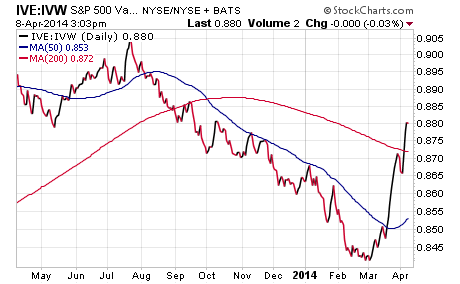2014 ETF Income Investing Ideas Part 3 – Alternative Strategies FMD Capital Management
Post on: 19 Апрель, 2015 No Comment

Written by David Fabian, January 03rd, 2014
In the first two articles of this three-part series on 2014 ETF income investing, I touched on my thoughts for fixed-income and dividend paying equities in the New Year. I generally divide my strategic income portfolio into three sleeves that include bonds, dividend paying equities, and alternative investments. This piece will focus on how to incorporate alternative strategies such as preferred stocks, master limited partnerships, and REITs into your income game plan.
With the 10-Year Treasury Note Yield holding steady at approximately 3% and the Fed committed to a near zero Fed Fund’s rate for the foreseeable future, income investors have to look for additional yield in unconventional places. Even a traditional dividend paying common stock is likely to only have a yield in the neighborhood of 3%, which may not cut it for a retired household that is looking to extend their savings for many more years.
The key to enhancing your income sources without taking an inordinate amount of risk is to carve out a small slice of your portfolio for avant-garde dividend paying sectors. Asset classes such as preferred stocks, MLPs, and REITs can often times be desirable because they do not correlate directly to equity or bond price movement. This allows you to diversify your portfolio holdings into areas of the market that may outperform traditional asset classes under the right circumstances. They can also help smooth out volatility by somewhat offsetting the price movement of other securities in your income mix.
In 2013, the performance of these alternative strategies was a mixed bag. The area that saw the most strength was master limited partnerships, of which the Alerian MLP ETF (AMLP) is still the biggest of the group with over $7 billion in total assets. The commodity sector had a volatile year; however the income stream that MLPs derive from their infrastructure leasing and development has been rock solid. AMLP gained over 18% last year and is currently paying a yield of over 6%, which is distributed quarterly.
One of the advantages of owning an ETF instead of an individual MLP is that you don’t have to deal with the tax headache of a K-1 on your tax return and you get the benefit of diversification amongst a similar segment of companies. If the economy stays on track and commodity prices (i.e. oil and natural gas) stabilize, I expect that MLPs will continue to perform well in 2014. However, they are susceptible to periods of volatility which is why it makes sense to have a sell discipline in place to define your downside risk.
Another area that I favor from a valuation standpoint is preferred stocks. The iShares U.S. Preferred Stock ETF (PFF) hugged the flat line in 2013, but has many attractive qualities for income seekers. It is currently paying a yield of nearly 6% and behaves as a hybrid instrument with both equity and debt characteristics. In addition, it is still more than 5% off of its most recent highs which makes a better value proposition than many dividend stocks trading near their all-time highs.
One of the advantages of preferred stocks is their non-correlated returns, as PFF currently has a beta to the S&P 500 of just 0.33. This sector is typically dominated by preferred holdings in financial companies, real estate, and banks. The monthly income stream from PFF is a luring quality and continued strength in the financial sector will likely bode well for this ETF moving forward.
On the flip side, the alternative income segment that saw the most weakness in 2013 is real estate investment trusts. Both traditional REITs and mortgage REITs were hit with extreme bouts of selling pressure on fears over rising interest rates which squeezed their operating profits. The Vanguard REIT ETF (VNQ) and iShares Mortgage Real Estate Capped ETF (REM) are two examples of ETFs in this space that had violent downward swings but are starting to find a bottom and looking more stable over the last six months.
The biggest risk to the real estate sector moving forward is the threat of an additional push higher in interest rates which would act as a headwind for further upside. However, this sector is also going to be closely tied to the success of the housing market which has continued to show signs of improvement on a month over month basis.
One conservative way to play this opportunity is through the actively managed Fidelity Real Estate Income Fund (FRIFX). This open ended mutual fund is made up of a unique mix of real estate stocks, mortgage REITs, mortgage backed securities, and other mortgage related debt. I currently own this fund for my own account and have been drawn to it largely because of its diversified asset mix, healthy dividend yield, and lower volatility.

Another fund to consider that has a healthy slice of all these alternative securities, along with dividend paying stocks and closed-end funds, is the Guggenheim Multi-Asset Income ETF (CVY). This ETF gives you the ability to own several different asset classes in a single vehicle with a yield of over 5%.
Conclusions
Alternative asset classes can offer unique price and income characteristics that may be appealing to those seeking to boost their dividend streams. Accessing these investments in the form of an ETF gives you instant diversification and exposure to very large and liquid indexes. However, they are not without their own set of risks.
If you are looking to establish new holdings in these undervalued sectors, I would recommend doing so with smaller allocations that you leg into over time. In addition, it always makes sense to have a risk management plan to guard against any unforeseen events that may result in the decline of these securities.
I hope that your 2014 investing endeavors will be enhanced by the ETFs and mutual funds that I have detailed in this article series. If you are looking for additional information concerning these three sleeves of investing, I invite you to download my special report: The Strategic Approach to Income Investing .
Best of luck in the New Year!
Looking for additional 2014 investment themes? View our latest video on the ETFs, mutual funds, and portfolio strategies we are implementing for our clients.














